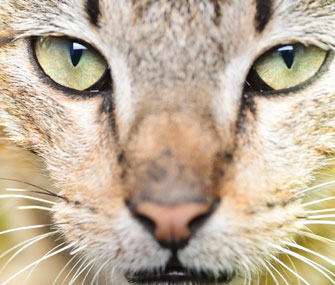Pet Vision vs. People Vision: Who Sees More?
Published on March 21, 2013

Do you ever wonder how much your pet sees, or if they see the same things with the same detail that you do? Although it seems like a relatively simple question, the answer is quite complex. When compared to human vision, dogs and cats see both better and worse… just a little differently than we do.
In general, dogs and cats are much more sensitive to light and motion than people are, but they cannot see as accurately or in the same immense color spectrum that we can.
Night Vision — Cats Rule
If you have ever wondered how your dog is able to go outside in the pitch black and make his way safely around, or how your cat can move so stealthily through a dark house at 1 a.m., it is because their eyes have amazing adaptations for nighttime — or nocturnal — vision.
Pets owe these abilities to their amazing light sensitivity. Both dogs and cats can detect very low levels of light and are far superior in this capability when compared to humans. But when it comes to night vision, cats rule — even over dogs. Cats need seven times less light than people do to make their way around in the dark. Their incredible nocturnal vision first comes from the vertical shape of their pupil and their very large eyes, which allow them to take in a maximum amount of light. Next, the shiny surface at the back of their eye — called the tapetum lucidum — reflects 130 times more light than a mere human eye, which allows them to function confidently in near-black conditions! Humans don’t have a tapetum at all, but both dogs and cats do. This structure in certain animal’s eyes is what causes them to reflect and appear green or yellow when caught in a beam of light at night.
Motion Detection
When it comes to detecting motion, both people and pets are better at seeing moving objects than stationary ones. People are 10 to 12 times better at detecting moving objects in bright light when compared to pets. However, pets outperform us in this category — paws down — in dim light.
A Dog Can See It All — Almost
Maybe dogs’ upbeat personalities come from their wide-ranging view of the world around them! People are capable of seeing 180 degrees around themselves without moving their head, and cats are similar with an estimated range of 200 degrees. But compare that to the average dog, which can see an incredible 240 degrees around himself. Brachycephalic dog breeds like the Pug — which have short noses and widely spaced eyes — can see an even wider range when compared to dogs with a longer nose and more forward-facing eyes, like a Greyhound. Regardless of the breed, a dog’s ability to see the world around himself is far greater than a person’s.
Do Pets Have 20/20 Vision?
No! 20/20 vision indicates the ability of a test subject to decipher the details of an object 20 feet away that a normal person could see from that distance. Using this scale, dogs come in at 20/75, and cats even further behind at 20/100 to 20/200. This means that from 20 feet away, nomal dogs can detect what a person with normal vision could detect at 75 feet away. The ability to perceive depth accurately and focus on multiple objects at differing distances is also far more limited in dogs and cats when compared to people. So this is one area where people excel!
The Color Question
Dog and cat eyes have far fewer color-sensitive cone receptors, so they do not see with the same spectrum that people do. Dog color vision appears to be the most similar to people who are red-green color blind. Dogs generally see in two hues — blue and yellow. Cats have color vision also, but to a lesser extent than dogs. While it seems to be difficult for pets to differentiate between red, orange, yellow and green, they interestingly outperform people on distinguishing multiple shades of grey. This ability is far more important for vision in dim light situations.
So, it is clear that dogs and cats see differently than people do, and this difference may be the explanation behind some behaviors that we humans just can’t fathom. While in some ways pet vision is not as good as ours, it is however finely tuned to give them specific advantages in certain environments — like your kitchen at midnight!
Do you wonder if your pet's vision is healthy and strong? Read about what your vet looks for during the opthalmic exam.





